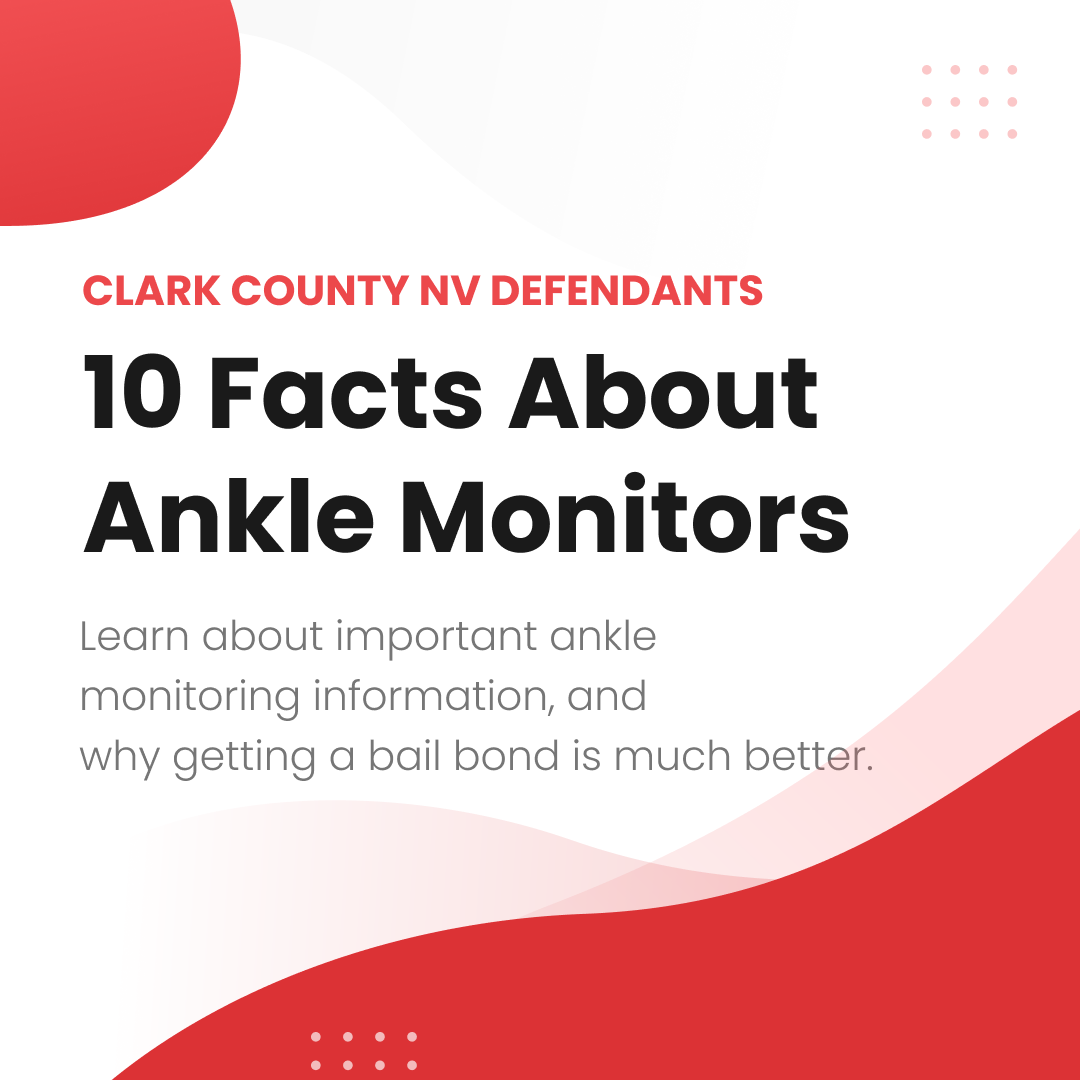Did you know that ankle monitors are becoming increasingly common in Clark County, Nevada? This shift, driven by political and policy changes, makes it crucial for defendants and their families to stay informed.
The purpose of this article is to inform readers of the 10 most important facts about ankle monitors in Clark County, NV. Keep reading to learn more.
1. Defendants with Serious Crimes Are Being Put On Ankle Monitors
Over the years, there has been a push for people to be released on their own recognizance in Clark County, NV. This trend has made it increasingly common even for those accused of serious offenses such as murder, strangulation, and battery to get released on ankle monitors.
While the shift towards ankle monitors is the inevitable conclusion of efforts to provide alternatives to pre-trial detention, it does open up a complex array of ramifications.
The Most Important Question: The main question for the average person living in Clark County to ask is, if I’m arrested in Las Vegas or elsewhere in the county, will I now be put on an ankle monitor?
Answer: It’s very possible. However, the decision to employ ankle monitors more frequently hinges on a variety of factors, including the nature of the alleged crime, the defendant’s history, and judicial discretion.
The problem is, if you’re facing an arrest, it’s hard to know where you’ll land in the court’s eyes. The unpredictability factor makes bail bonds all the more necessary.
The Bottom Line Is: If you don’t bail out, you risk being put on an ankle monitor in Clark County!
2. Defendants Face A Higher Chance of Ankle Monitoring Than Ever
Just to reiterate: Not only do you risk being put on an ankle monitor in Clark County if you are arrested, but thanks to policy changes, you have a higher likelihood than ever before!
Part of the reason for this shift, beyond political changes, is that ankle monitoring technology has advanced considerably, making it convenient for courts to use.
Evolving Ankle Monitor Technologies:
Today’s ankle monitoring devices come equipped with useful features, such as alcohol monitoring, as one example.
SCRAM stands for Secure Continuous Remote Alcohol Monitor, and it’s the technology used in Clark County, NV for said purpose. It relies on a noninvasive transdermal analysis to monitor alcohol levels in sweat.
This is an example of evolving technologies that put defendants under a new type of surveillance, and it’s one reason Clark County, NV has adopted ankle monitors so widely.
Question: If arrested, how likely exactly is an ankle monitor in Clark County, NV?
Answer: It’s hard to say because the decision to assign an ankle monitor is highly contingent on multiple case-specific factors. These include the severity of the crime, the individual’s criminal history, the defendant’s ties to the community, and any flight risk or threat they might pose.
Our best advice is don’t take a chance. When you wait for a court decision on pre-trial release conditions instead of bailing out, then you’re left at the mercy of the court.
3. Advice from Jailers Can Be Misleading
When in jail, you might hear, “Just wait it out. You’ll probably be released on your own recognizance (OR).”
In our opinion, you don’t want to listen to the jailer’s reassurances about automatic release on your own recognizance in Clark County, NV.
While it’s true that OR releases do occur and represent an ideal scenario for some defendants, this outcome is far from guaranteed, and there are plenty of problems that come along with being released on OR in any case.
Banking on an OR release is a risky strategy that may not pan out as expected.
Bail Is Better:
The prevailing wisdom for those detained in Las Vegas should be to actively pursue bail options rather than passively waiting for a court to potentially grant an OR release.
The advice from jailers to avoid contacting a bail bondsman really does run counter to the interests of many defendants who seek to minimize their time in custody and maintain their employment, family responsibilities, and personal obligations.
Opting to post bail through a bondsman provides a more reliable path to freedom while awaiting trial.
IMPORTANT:
Some defendants may find themselves offered release on their own recognizance on the condition they wear an ankle monitor. While this may seem advantageous at first glance, it comes with significant drawbacks.
Firstly, the imposition of an ankle monitor places the defendant under strict surveillance, limiting their movements and potentially imposing curfews or geographic restrictions that can interfere with daily life.
Secondly, the financial burden associated with an ankle monitor—through monthly fees for the device’s operation—can quickly accumulate, often surpassing the cost of a bail bond over time.
Thirdly, you might have to wait up to two weeks in custody while waiting for an ankle monitor to become available!
4. Ankle Monitors Are A Financial Burden
Below is a breakdown of the typical costs associated with the use of an ankle monitor in Clark County, NV.
Installation Fee: An initial fee for attaching the device, which ranges from $50 to $100.
Daily Monitoring Fee: A recurring charge for the continuous monitoring of the individual’s location, costing between $10 – $12 per day, which factors to $300 – $360 per month.
Daily House Arrest Monitoring Fee: $13 – $15 per day, which factors to $390 – $450 per month.
These costs can be tough for low-income individuals and families to afford, especially over long periods of time. For this reason, it’s important for individuals and their families to be aware of these potential expenses when considering their options for pre-trial release.
Additional Considerations:
The visibility of an ankle monitor can pose challenges in securing employment, as potential employers may have reservations about hiring someone under surveillance. This can exacerbate financial difficulties by limiting job opportunities.
Moreover, ankle monitors can limit an individual’s ability to work if their job requires travel outside certain geographical limits. This can result in lost job opportunities or the need to find new employment within the designated area, potentially at a lower wage.
All of this only compounds the problems with ankle monitors, which are easily avoided with a bail bond.
5. Release On OR WILL Lead to Ankle Monitoring or A Tracking App
Hoping for a release on your own recognizance (OR) in Clark County, NV? Be prepared for an ankle monitor or a tracking app as part of the deal.
The stark reality in Clark County is that opting not to post bail almost invariably means you’ll be subject to some form of monitoring. This is because being ROR’d involves strict conditions to ensure you stay within certain boundaries and make all necessary court appearances.
Such conditions often mandate electronic monitoring, whether through a traditional ankle monitor or, increasingly common, a mobile tracking app. Both methods are designed with a singular aim: to keep a watchful eye on your movements.
6. Bail Bonds Offer a Non-Tracked Alternative to Ankle Monitors
Being tracked by an ankle monitor can take a toll on an individual and their loved ones. The same goes for being stuck in jail while waiting for pre-trial release. It’s not a good situation.
Fortunately, for those looking for an alternative to electronic monitoring, a bail bond offers a faster path to freedom while awaiting trial. In fact, we can write a bail bond in just 15 minutes.
Get out of jail fast and return to the comforts of home and your loved ones with All n One Bail Bonds today!
Additional benefits of getting a bail bond include:
Enhanced Privacy: Opting for a bail bond means you won’t be tracked with an ankle monitor or tracking app.
Reduced Stress and Anxiety: The psychological impact of being monitored can be significant. Removing the possibility of electronic surveillance by choosing a bail bond reduces stress and anxiety, not just for the individual involved but also for their family members, who may feel the secondary effects of such monitoring.
No Additional Financial Burdens: Electronic monitoring devices come with installation and daily monitoring fees. These can add a considerable financial burden on top of legal expenses. When you get a bail bond through All n One Bonding and Insurance, Inc., you can opt for a one-time financial arrangement or participate in a custom payment plan tailored to your needs.
95% of our bonds are written without collateral, and we offer low down payment with interest-free weekly, bi-monthly, and monthly payment options.
We accept 5% down, 4% down, 3% down, or even less if the client has collateral. All payment plans are interest-free, and the only fee we charge is a collection fee. We don’t charge late fees/finance fees.
Freedom to Work and Live Normally: Being on bail without electronic monitoring means you can continue to work and fulfill family obligations without the restrictions that ankle monitors impose.
Support Through the Bail Bondsman: Avoiding an ankle monitor or tracking app means your compliance with pre-trial conditions remains a matter between you, your bail bondsman, and the court. Our bail bondsmen provide guidance throughout the bail process, helping keep you accountable and ensuring you show up for court. This support is invaluable, especially for those unfamiliar with the court system.
Opportunity for a Better Defense: Being out on bail without the constraints of an ankle monitor or house arrest allows for easier communication with legal counsel.
7. Ankle Monitors in Clark County, NV Come with Housing Restrictions
The use of ankle monitors in Clark County, NV, introduces two main challenges.
Challenge 1:
The process of being placed under electronic surveillance with an ankle monitor is not immediate and can extend up to 14 days. This delay is significant, especially for those eager to return to their lives but find themselves caught in procedural limbo.
No one with a family and career wants to spend 14 days in jail while they wait for an ankle monitor!
Ideally, with an ankle monitor, the process is as follows: You get arrested, you go to court the next day, then you get released, put under house arrest, and then the following day, your house gets checked.
There are a couple of reasons why this process can take up to 14 days. One is administrative backlogs in processing requests for monitors, especially in high-volume jurisdictions like Clark County. Another is logistical issues, such as scheduling the fitting of the device.
Challenge 2:
The monitored individual cannot live in a home where a felon resides. This requirement necessitates a thorough inspection of the house to ensure compliance, which not only adds to the procedural delay but also may force difficult decisions and changes in living situations.
If a family member or roommate has a felony conviction, the individual facing monitoring must find alternative housing or request that the felon relocate, neither of which are simple or stress-free solutions.
8. Ankle Monitor Conditions Limit Freedom of Movement
When a defendant is placed on an ankle monitor in Clark County, NV, they face significant limitations on their freedom of movement.
These restrictions are tailored to each individual’s case, but generally, conditions include the following.
Designated Areas:
Defendants may be restricted to specific geographical areas, such as their home or workplace. Venturing outside these zones without permission can trigger alerts to the police.
Curfews:
Many under electronic surveillance in Clark County, NV must adhere to strict curfews requiring them to be at their residence during specified hours, usually overnight. This can limit personal and social activities.
Travel Restrictions:
Permission for travel outside the immediate area, even within Clark County, may need to be obtained in advance from an officer or the court. This can complicate plans for work, education, or family gatherings.
Prohibited Areas:
Certain individuals may be barred from visiting specific places known for criminal activity or that could pose a risk to their rehabilitation, such as bars or clubs.
9. Ankle Monitors Affect the Defendant’s Family and Dependents
Ankle monitors not only impact defendants but also their family members. This broader impact can manifest in various ways.
Emotional and Psychological Impact: Family members, especially children and partners, can experience stress and anxiety due to the presence of an ankle monitor.
Financial Strain: As already mentioned, the cost associated with ankle monitoring places an additional financial burden on families.
Logistical Constraints:
Ankle monitors can limit family activities, such as vacations, social events, or even simple outings like dining out.
Planning any activity outside the home requires careful consideration of the defendant’s legal restrictions, leading to a sense of confinement for the entire family.
Community Relationships:
Families will likely experience shifts in their relationships within the broader community. Participation in community events, social groups, or volunteer activities can be hindered, affecting the family’s sense of belonging and support.
Employment and Housing Challenges: Family members may need to relocate if their current residence doesn’t meet the conditions set by the court.
Increased Responsibilities:
Other family members may need to assume additional roles and responsibilities to compensate for the defendant’s restrictions.
This might include driving them to work, attending meetings, or handling tasks the defendant cannot manage due to restrictions.
10. There Is No Credit for Time Served with Ankle Monitors in Las Vegas
When someone is on an ankle monitor in Clark County, NV, what essentially happens is the representative of the county (for example, the sheriff) will inform them that they are now in custody and must abide by certain restrictions.
However, the person in custody does not get time served for being tracked!
A Big Problem with Ankle Monitors in Clark County, NV:
This discrepancy has important implications for defendants. Primarily, it extends the overall duration of legal penalties beyond what one might expect.
While the purpose of ankle monitoring is to keep defendants from fleeing while they await their court dates, this becomes problematic, considering a trial could take weeks or months to complete.
Prepare For Court Without Being Tracked:
However, when a new arrest occurs in Clark County, and a bond is posted before the defendant goes to their first court date, they will be given a court date between 30 and 120 days away. They can spend this time preparing for their court date without being tracked.
FAQs: Ankle Monitors in Clark County, NV
Read this section for frequently asked questions about ankle monitors in Clark County, Nevada, and the greater Las Vegas area.
What crimes get an ankle monitor in Clark County, Nevada?
Today, more crimes than ever before are likely to receive an ankle monitor in Clark County, NV.
Substance Abuse and Sex Crimes:
With that said, ankle monitors are most commonly used when the defendant has a history of substance abuse and is in a recovery program. Additionally, individuals convicted of sex crimes, especially those on probation, are frequently required to wear ankle monitors.
Other Types of Crimes That Receive Ankle Monitors:
- In domestic violence cases, ankle monitors are used to enforce restraining orders by ensuring the defendant does not enter designated exclusion zones.
- For repeat DUI offenders, ankle monitors equipped with alcohol monitoring capabilities (SCRAM devices) will be used.
- For non-violent offenders who are deemed to be low risk, ankle monitors are often used to reduce jail populations while maintaining oversight.
- Individuals awaiting trial for various offenses may be placed on an ankle monitor as a condition of their release.
What factors determine the use of ankle monitors?
Risk Assessment: Nevada courts rely on risk assessments to determine the likelihood of re-offending or failing to appear. Higher-risk individuals are more likely to be placed on electronic monitoring, assuming they are released at all.
Capacity of Local Jails: Overcrowding in jails can lead to the increased use of ankle monitors.
Community Safety: The need to protect the community from harm plays a crucial role in the decision to use ankle monitoring, especially for offenders with a history of violent or sexual crimes.
Compliance with Treatment Programs: For individuals involved in recovery or treatment programs, ankle monitors are used to ensure adherence to requirements.
Are ankle monitors tracked in real time?
Yes, they are, although there may be signal delays.
GPS-enabled ankle monitors accurately track the wearer’s location anywhere outdoors, allowing police to see in real-time if the individual goes beyond designated areas. RF technology may also be used to ensure that an individual remains within a certain range.
Today, ankle monitors use GPS or RF technology.
Do you have to sleep with an ankle monitor on?
Yes, individuals who are required to wear an ankle monitor must keep it on at all times, including while sleeping. Ankle monitors are designed to be worn 24/7.
The ankle monitor is securely fastened to the wearer’s ankle and can only be removed by authorized personnel. Tampering with or attempting to remove the ankle monitor is considered a violation of the terms of release.
How uncomfortable is an ankle monitor?
Fairly uncomfortable, generally speaking, although different people find them more or less tolerable. Some common issues are the weight and bulkiness of the monitor, especially during the initial adjustment period, and skin irritation.
In more serious cases, prolonged wear can lead to chafing under the device, particularly if the monitor is not properly fitted. This is an issue that can be made worse by sweat or a lack of air circulation around the strap area.
Beyond physical discomfort, the visibility of an ankle monitor can be embarrassing and emotionally painful.
What happens if your ankle swells while wearing an ankle monitor?
If medical issues, such as ankle swelling, occur, the ankle monitor can be relocated to the opposite ankle with the supervision of law enforcement. This ensures that any changes to the device’s placement are authorized and documented.
However, the situation becomes more complex in more severe cases where both ankles are affected by swelling, whether due to an injury, a medical condition, or another health-related issue. This situation would require an emergency hearing with the court to solve.
What happens if an ankle monitor is tampered with or removed?
We strongly suggest that you do NOT tamper with your ankle monitor!
According to the Clark County Nevada government website, tampering with your device could result in a financial charge and criminal prosecution. Additionally, it will likely result in getting arrested and taken back into custody.
Are ankle monitors associated with the names of the defendants?
Yes, ankle monitors are associated with the names of the defendants who are required to wear them.
When an individual is placed under electronic monitoring, the device is registered specifically to them. The defendant’s personal details, including their name, are entered into the monitoring system, and other identifiers may also be entered.
Note: If you’re wondering about public records, the clerk of court maintains records of all court proceedings, including orders for electronic monitoring. If you are a defendant, your name will be part of the public record associated with your case, and this record can include the fact that electronic monitoring was ordered as part of your release.
Contact All N One Bonding and Insurance, Inc.
If you want to avoid the hassle of an ankle monitor, such as being stuck in custody for up to two weeks while you wait for a monitor, paying ankle monitoring fees, or having your movements tracked, then getting a bail bond is absolutely the right choice!
With a bail bond, you can get back to work the next day, be with your family, take care of them, pay rent, and do what you need to handle your case.
Our job is to get defendants back on track and get them through the process so that it doesn’t hurt them or their families. Visit our contact page or call us for more information. We’re here to help!





